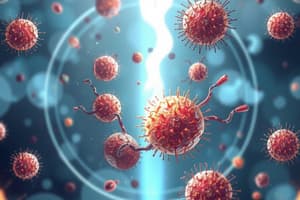Podcast
Questions and Answers
What is the purpose of pasteurization of milk?
What is the purpose of pasteurization of milk?
- To increase the composition, flavor, and nutritive value of milk
- To rapidly cool milk to 4°C
- To destroy any pathogens that may be present in milk (correct)
- To decrease the shelf life of milk
What temperature range is milk kept at during pasteurization?
What temperature range is milk kept at during pasteurization?
- 50-55°C
- 63-66°C (correct)
- 80-85°C
- 70-75°C
Which method involves rapidly heating milk to nearly 72°C?
Which method involves rapidly heating milk to nearly 72°C?
- UHT Method
- Low Temperature and Long Time Method
- Ultra Rapid Method
- High Temperature and Short Time Method (correct)
What is the cooling temperature for milk after pasteurization using the UHT Method?
What is the cooling temperature for milk after pasteurization using the UHT Method?
Which method allows very large quantities of milk per hour to be pasteurized?
Which method allows very large quantities of milk per hour to be pasteurized?
Flashcards are hidden until you start studying
Study Notes
Food Safety Hazards
- Food safety hazards are contaminants that potentially render a food product unsafe for consumption.
- A hazard is defined as biological, chemical, or physical agents in food that may lead to adverse health effects.
Sources of Hazards
- Hazards can originate from raw ingredients or develop during food processing and handling.
- Awareness of potential hazards related to specific ingredients and the processing environment is essential for safety.
Types of Hazards
-
Biological Hazards:
- Include pathogens that cause infection or intoxication.
- Common microorganisms:
- Escherichia coli
- Bacillus cereus
- Campylobacter jejuni
- Clostridium botulinum
- Salmonella
- Shigella
- Staphylococcus aureus
- Various viruses.
-
Chemical Hazards:
- Include harmful chemicals present in food ingredients.
- Examples are mycotoxins (e.g., aflatoxins, patulin, vomitoxin, fumonisin), pesticides, allergenic materials, and heavy metals.
-
Physical Hazards:
- Encompass foreign objects that can cause injury or choking.
- Examples of physical contaminants: glass, metal, stones, wood, plastic, pests, and other intrinsic natural materials.
Studying That Suits You
Use AI to generate personalized quizzes and flashcards to suit your learning preferences.




